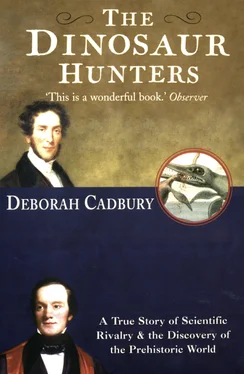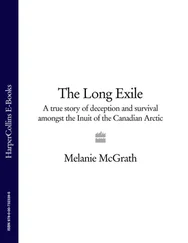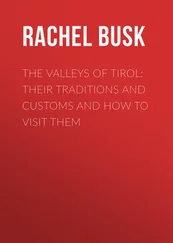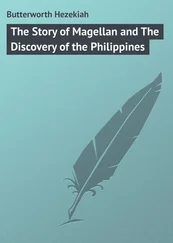Apart from revealing the age of the earth, the Bible had other geological implications that were to prove equally challenging for the early geologists like William Buckland. The prophet Moses outlined the story of Creation in which God made the Heavens, the Earth and every living thing in just seven days. In the biblical Creation story all creatures were made simultaneously. There is no prehistory in the Bible, and no prehistoric animals.
Moses also described a universal Flood in which ‘all the fountains of the great deep and the windows of heaven were opened’, and the entire face of the earth was wiped out, destroying all creatures except the few saved in Noah’s Ark. Sacred texts were scrutinised so as to shed more light on these events. One highly respected seventeenth-century naturalist, a German Jesuit, Athanasius Kircher, produced a detailed paper on the dimensions of the Ark and its animal contents. This approach was still flourishing in 1815, when the Reverend Stephen Weston studied changing place-names in Hebrew and Greek and claimed to locate the very site where Noah’s Ark came to land – on one of the highest mountains of the earth in Tibet.
At Oxford, William Buckland knew that anomalies unearthed in the rocks during the eighteenth century had challenged religious scholarship. Many stones resembling creatures or plants had been uncovered in locations that defied explanation. How could it be that sea shells were found on the peaks of the highest mountains? Was this evidence for the Flood and, if so, how had such vast amounts of water been suddenly generated and then fallen away? Savants were hard-pressed to explain why stones that looked just like animal teeth were found deeply embedded in solid rock, or how plants had become petrified within layers of coal. If fossils were the remains of animals, why were bones of tropical animals found in cold northern regions? Had the climate been mysteriously inverted? Stranger still, why was it that fossils resembling fish buried in one rock could be covered by layers of rock that contained only land animals, and in turn have shells and sea plants in the rocks above? This seemed to provide evidence of astonishing disorder and devastation, which was hard to understand if the world was purposefully designed in seven days by the Almighty Creator.
By the late eighteenth century scholars were making progress in understanding the history of the earth, not by taking the Bible as evidence, but the rocks themselves. One of the spurs for this was the growth of the mining industry in parts of Northern Europe such as Thuringia and Saxony. It was here on the present border between Germany and Poland that a pioneering thinker, Abraham Werner, created an order out of the seemingly haphazard formation of rocks beneath the earth’s surface.
Abraham Werner was taken out of school at Bunzlau when his mother died, and sent to work for his father who managed the local ironworks for the Duke of Solm. He later entered the great Mining Academy of Freiberg, where his teaching on mineralogy became famous throughout Europe. Werner’s ideas and others’ showed that the earth’s crust could be classified into four distinct categories of rock, which were always found to be in the same order of succession. The oldest of these were the crystalline rocks such as granite, gneiss and schist, containing no fossils. These became known as the Primary rocks, corresponding to the most primitive period of the earth’s history, since these rocks were laid down first in the earth’s crust. Above these in order of succession were the Transition rocks, including greywackes, slates and limestone. Only a small number of fossils could be found here. This was followed by the Secondary period, with highly stratified rocks, sandstones, limestones, gypsum and many other layers, filled with fossils. Finally, the most recent were the generally unconsolidated deposits of gravels, sand and clays, corresponding to the Tertiary period.
Rather than accepting that the earth’s crust had formed in a mere six thousand years, Abraham Werner speculated that the older Primary and Transition rocks had formed more than a million years ago, by precipitation from a universal ocean that once enveloped the whole world. His theory implied that the order of rocks he had identified in Saxony would be found elsewhere. If his observations were right, the consequences of his findings were huge, as they were proof that locked within the earth’s crust was evidence of distinct periods in its formation. By identifying an order in the layers of rock, Werner was offering the world a glimpse of prehistory.
Even more perplexing amid the lecture-rooms of deans and bishops at Oxford was a new theory put forward by a Scotsman, James Hutton. He did not accept Werner’s view that the older rocks had precipitated from a universal ocean, but envisaged that they were formed gradually by erosion and deposition. This led him to speculate that the history of the earth was so vast it was almost immeasurable.
From his observations Hutton inferred that the earth was caught in an endless cycle of forming and re-forming the landscape: cycles in which rivers carried sediment from the land to the sea; layers of sediment gently accumulated and compacted into stone on the sea floor, until earth movements lifted the layers out of the sea, folding the different strata to form a new landscape. Since, he reasoned, the erosion of land and the accumulation of sediment take millions of years, the only conclusion was that the landscape had formed over millennia. In his book, Theory of the Earth, he wrote of the earth’s history, ‘there is no vestige of a beginning and no prospect of an end’.
The ideas of Hutton, Werner and others opened the door to an unfamiliar landscape as well as a vast, unknown history of the earth. This abyss of geological time was almost as strangely unbelievable as the vastness of stellar space opened up by Copernicus in astronomy two centuries earlier. The new theories questioned the long-established chronology for the earth’s age of Archbishop Ussher, and with it, the authority of the Bible. Many thinkers felt that this was a dangerous pursuit. Richard Kirwan, President of the Royal Academy in Ireland, was one of several leading thinkers to ridicule Hutton’s claims, pointing out that this was ‘fatal’ to the account in Moses and therefore a threat to morality. Hutton’s theory was so obviously flawed that Kirwan had found it quite unnecessary to even read it!
William Buckland, brought up in the heart of the Anglican establishment but drawn to a rigorous, scientific approach to gathering evidence, was eager to understand the true history of the globe within which fossils could be correctly understood. Wishing to reconcile the two seemingly opposing sides of his nature, he dedicated himself to proving that religion and science did not stand opposed to each other, but were complementary. For him, geology was a ‘master science’ through which he could investigate the signature of God.
In 1813, when Buckland was appointed Reader in Mineralogy at Oxford, such was his enthusiasm to make sense of the apparently conflicting opinions about the earth’s history that he embarked on a detailed study of all the rocks of England, travelling with his friend, George Bellas Greenough. Greenough had helped to found the Geological Society of London in 1807. This began as a ‘little talking Geological Dinner Club’ in a central London tavern, and had rapidly blossomed into a scientific society which aimed to ‘make geologists acquainted with each other, stimulate their zeal … and contribute to the advance of Geological Science’.
Touring with Greenough, Buckland aimed to construct a geological map for the Society of all the strata they could identify, showing the different layers of rock in each region and comparing the fossils within them. Would the layers of rock in England correspond to those in the European rocks? What did the different formations reveal about prehistory?
Читать дальше












